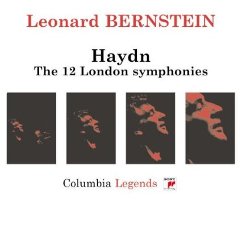Haydn - The 12 London Symphonies (Bernstein) CD3 [2003]
Haydn - The 12 London Symphonies (Bernstein) CD3 [2003]

Symphony in B flat major, Hob.I No.98 1.Adagio, Vivace 2.Adagio 3.Menuet. Allegro, Trio 4.Finale. Presto Symphony in E flat major, Hob.I No.99 5. Adagio, Vivace assai 6. Adagio 7. Menuet. Allegretto, Trio 8. Finale. Vivace New York Philharmonic Leonard Bernstein – conductor
Composed early in 1792 and premiered on 2 March, three weeks before the ‘Surprise’, No 98 in B flat major is a more serious, inward-looking work, at least in its first two movements. ‘The new Symphony in B flat was given, and its first and last Allegros encored’, noted Haydn laconically in his London Notebook. The success of the intently argued opening movement testifies to the sophistication of Haydn’s audience. Its fertile main theme, adumbrated starkly in B flat minor in the slow introduction, is worked with dazzling ingenuity and logic. Contrast comes courtesy of a sustained, chromatic oboe melody over a pedal point near the end of the exposition. After one of Haydn’s most intricate and stressful contrapuntal developments, the recapitulation continues to explore the theme’s polyphonic potential before finally presenting it in its bluntest, most elemental form.
It was the musicologist and composer Donald Tovey who first suggested that the Adagio was Haydn’s requiem for his friend Mozart, who had died the previous December. Certainly the echoes of the ‘Jupiter’ Symphony’s Andante are hard to miss in this sublime movement, in full sonata form. In the recapitulation, the hymn-like main theme (which Haydn seems to have modelled on ‘God save the King’) is poignantly intensified, first with a counterpoint for solo cello, then in woodwind imitation, and finally in an aching new chromatic harmonization. Even the minuet, with its suavely melodious trio, is less flamboyant than those in Nos 93, 94 and 96. There is a delicious moment in the second part when the music dips insouciantly from F major to A flat for a demure flute solo. Haydn the humorist is immediately to the fore in the irrepressible 6/8 finale. The cheeky second theme belongs to the world of Rossini’s Figaro (the Italian was a great admirer of Haydn’s symphonies); and the comedy continues in the development, with its violin solos for Salomon in wildly contrasting keys, and the huge coda. Near the end, after what sounds like a pause for a cadenza, Haydn slows down the main theme with mock solemnity, and then decorates it with a ‘cembalo [i.e. fortepiano] solo’ for himself—an effect that doubtless brought the house down in 1792. ---Richard Wigmore, hyperion-records.co.uk
After No 99’s premiere at the Hanover Square Rooms on 10 February, the Morning Chronicle wrote that ‘it rouses and affects every emotion of the soul.—It was received with rapturous applause.’ For the first time in a symphony Haydn was able to call on clarinets, whose presence is immediately felt in the slow introduction’s majestically sonorous opening chord. Then, as the chord dies away, Haydn tellingly exploits the clarinet’s deep, chalumeau register as a sustained bass to strings and bassoon. The introduction is Haydn’s most harmonically adventurous to date, with an emphasis on mediant, or ‘third-related’, keys that will have repercussions later in the symphony. After a dramatic pause on a unison C flat, this note is enharmonically reinterpreted as B natural, heralding a brief excursion to the exotically remote key of E minor.
Repeated emphasis on the introduction’s alien C flat gives a tangy, chromatic flavour to the Vivace assai’s sweeping tuttis. Most striking, though, is the way the popular-style second subject, breezing in like an afterthought, gradually usurps the musical narrative. After dominating the development (which slips almost immediately to C major), it virtually crowds out the main theme from the recapitulation, generating one of those exhilarating expansions that led Tovey, rather misleadingly, to equate Haydn’s recapitulations with Beethoven’s codas.
‘The effect of the wind instruments in the second movement was enchanting’, wrote the Morning Chronicle, a reference to the beautiful contrapuntal elaboration of the opening theme by flute, oboes and bassoon. Set in the luminous, ‘third-related’ key of G major, this is music at once tender and exalted, with a dramatic, even anguished, development and a recapitulation that works the serene second theme to a disturbing climax replete with military-style fanfares. The powerfully symphonic minuet continues the work’s ‘mediant’ tendency by setting its wistful Ländler trio in C major. Clarinets then oversee a subtle lead-back to the E flat of the minuet. The finale, initiated by another irresistibly catchy tune, is a tour de force of kaleidoscopic orchestral colouring (the ‘second subject’ fragments the melody between instruments, like a comical mini-concerto for orchestra) and contrapuntal brilliance. The young Beethoven, who learnt far more from Haydn than he ever admitted, was so impressed with the scintillating fugato at the centre of the movement that he copied it out for study. ---Richard Wigmore, hyperion-records.co.uk
download (mp3 @320 kbs):
yandex 4shared mega mediafire cloudmailru uplea








